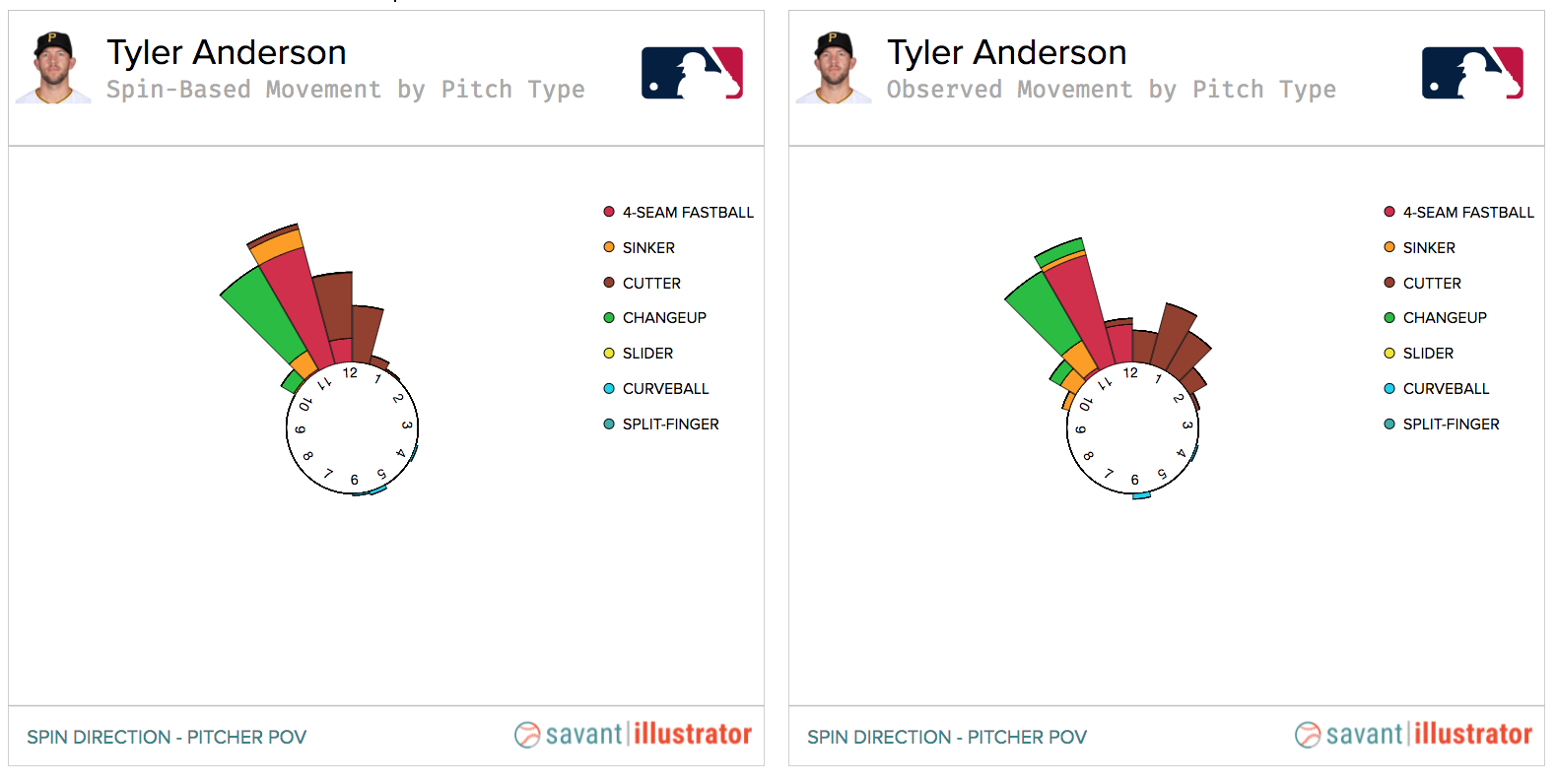Mediocrity is the best way of describing Tyler Anderson’s career to date. Holding a career 4.58 ERA (98 ERA-, where 100 is average) and a 90 MPH fastball, the southpaw is perfectly average. There was more envisioned for him when the Rockies drafted him 20th overall back in 2011, but he’s now two seasons removed from being in the Mile High City. Even pitching with San Francisco last year, Anderson struck out a paltry 15.8% of hitters. Through five starts in Pittsburgh this season, the difference between his strikeouts and walks is 16.3% (23.6% K, 7.3% BB). The path to get to this point has come from fairly radical changes.
Improvements To The Fastball And Cutter
The four-seamer has shown the greatest leap this season compared to past seasons.
Anderson has added nearly 150 RPM in spin to his four-seamer — and 0.6” less drop — which is why, despite losing velocity, that the left-hander consistently has gotten swings and misses on the heater.
| Season | Usage (%) | Velocity (MPH) | Spin Rate (RPM) | Horizontal Movement | vs AVG (+/-) | Vertical Movement | vs AVG (+/-) | SwStr% |
|---|---|---|---|---|---|---|---|---|
| 2016 | 44.0 | 91.4 | 2184 | 10.5 | 2.6 | 14.9 | -0.1 | 8 |
| 2017 | 45.1 | 92.0 | 2240 | 9.4 | 1.8 | 13.2 | 1.7 | 7.5 |
| 2018 | 39.6 | 91.9 | 2250 | 7.7 | 0.6 | 15.9 | 0.6 | 8.5 |
| 2019 | 46.5 | 91.2 | 2333 | 8.4 | 1.7 | 15.6 | 1.2 | 10.6 |
| 2020 | 40.7 | 90.3 | 2304 | 7.8 | 1.7 | 14.6 | 2.0 | 8 |
| 2021 | 32.6 | 90.2 | 2448 | 8.8 | 2.4 | 14.0 | 2.4 | 14.8 |
Next, we’ve got the cutter.
Anderson’s cutter has seen a drop in velocity over the years but it has also added over 200 RPM, relative to last season. In addition to more spin, there’s also been added vertical movement relative to the average.
| Season | Usage (%) | Velocity (MPH) | Spin Rate (RPM) | Horizontal Movement | vs AVG (+/-) | Vertical Movement | vs AVG (+/-) | SwStr% |
|---|---|---|---|---|---|---|---|---|
| 2016 | 26 | 86.9 | 2367 | 1.2 | -1.8 | 24.5 | 1.9 | 7.8 |
| 2017 | 22.4 | 87.5 | 2415 | 1.2 | -1 | 24.6 | 2.4 | 13.1 |
| 2018 | 28.7 | 87.6 | 2464 | 2 | -0.2 | 26.2 | 1.7 | 14.7 |
| 2019 | 19.4 | 87.0 | 2548 | 1.4 | -0.9 | 24.8 | 4.3 | 15.7 |
| 2020 | 18.1 | 85.0 | 2415 | 3.2 | 0.1 | 28.1 | 2.5 | 12.7 |
| 2021 | 28.3 | 84.1 | 2626 | 2.6 | -1.2 | 28.3 | 3.7 | 13.8 |
Also, take a look at the deviation of the observed and inferred spin axes on the pitch:
Now, if you haven’t read Nicklaus Gaut’s recent piece on seam-shifted wake (SSW) and its relation to cutters, you should do that now. What the article describes is how cutters with the greatest SSW (the top 25%) have lower run values (-0.61) per 100 pitches than those with the lowest amount (bottom 25%) of SSW (+0.58), which bodes well for Anderson. Furthermore, as you read that piece — and observe the image above — you’ll notice that Anderson’s cutter has had 45 min (relative to the clock) of deviation in 2021, putting him near the top of the leaderboard.
With that pitch, Anderson has not only able to generate a good number of swinging strikes (13.8% SwStr) but also garner a ton of weak contact. Of pitchers that have thrown the cutter at least 50 times this season, Anderson has induced 14 poorly hit balls, which is 13th-best in the early going. As a pitch that can both get swings and misses and induce weak contact, it’s easy to see why the cutter is so critical to Anderson’s success.
On The Attack
As mentioned previously, Anderson has done a great job of striking out more batters and walking fewer batters, as evidenced by his 16.3% K-BB. The key to that is to throw pitches in the zone (54.9%) and subsequently throw as many pitches with two strikes (33.6%) as possible.
For someone like Anderson, who isn’t gifted with a blazing fastball or an elite breaking pitch, trusting your stuff would seemingly be hard to do. But with his heater and cutter, Anderson has insisted on shoving it right down hitter’s throats, putting both pitches in the heart of the zone very often.
| Season | FF% | FC% |
|---|---|---|
| 2016 | 29.3 | 24.3 |
| 2017 | 32.3 | 20.5 |
| 2018 | 34 | 27.5 |
| 2019 | 33.2 | 22.9 |
| 2020 | 29.1 | 20.2 |
| 2021 | 38 | 36.6 |
From Little League on up, living in the middle of the zone is something you’re taught to avoid as a pitcher. You want to make quality pitches on the edges, and try and keep the ball off the fat part of the bat. But in the age of analytics, pitchers embrace what they are best at, regardless of what convention might have been years ago. For Anderson, that’s living in the middle of the zone with his fastballs, since he does so well with it.
| Season | FF% | FC% |
|---|---|---|
| 2016 | 7.1 | 7.9 |
| 2017 | 17.2 | 9.4 |
| 2018 | 5.8 | 11.7 |
| 2019 | 21.1 | 16.7 |
| 2020 | 8.6 | 11.5 |
| 2021 | 15.6 | 25.9 |
On both pitches, Anderson is posting above league average rates this season (14.2% SwStr and 13% SwStr, respectively). While that’s undoubtedly a positive for his pitch profile, there’s also the downside of this approach since it gives the batter a greater chance of making good contact.
| FF | FC | |||
|---|---|---|---|---|
| Season | wOBA | xwOBA | wOBA | xwOBA |
| 2016 | 0.330 | 0.314 | 0.359 | 0.311 |
| 2017 | 0.446 | 0.381 | 0.43 | 0.36 |
| 2018 | 0.469 | 0.363 | 0.453 | 0.366 |
| 2019 | 0.603 | 0.477 | 0.582 | 0.545 |
| 2020 | 0.401 | 0.400 | 0.404 | 0.391 |
| 2021 | 0.295 | 0.470 | 0.195 | 0.473 |
With such a drastic gap between his current and expected performance on those pitches, there’s surely going to be massive regression, right?
This is where Anderson’s changeup comes into play. The southpaw’s offspeed pitch has been a Money Pitch so far, with 44.4% O-Swing, 40.5% Zone, 17.4% SwStr. And contrary to the way he uses his fastballs, Anderson has adeptly used his changeup on the fringes of the zone, a combined 75.2% in the shadow and chase regions.
Armed with that destructive offering, we seemingly get a better understanding of how Anderson’s strikeouts have improved to a career-high rate.
With that said, we’ve so far only discussed general usage. To shift the focus and center the discussion on strikeouts, we need to understand how Anderson is attacking hitters with two strikes. Surely, this would include raising his changeup usage in such situations.
| Season | FF% | FC% | CH% | SI% | CU% |
|---|---|---|---|---|---|
| 2016 | 44.6 | 23.2 | 30.8 | 0 | 1.4 |
| 2017 | 39.2 | 24.9 | 34.7 | 1.2 | 0 |
| 2018 | 37.9 | 32.2 | 25.3 | 2.1 | 2.5 |
| 2019 | 48.2 | 24.1 | 23.4 | 0.7 | 3.5 |
| 2020 | 36.7 | 21.2 | 38.6 | 3.4 | 0 |
| 2021 | 41.1 | 27.4 | 21.9 | 8.2 | 1.4 |
Well, that’s definitely not what was expected. Not only is he shelving the changeup, relatively speaking, but he’s also throwing the sinker at a non-zero percentage. It’s especially baffling given that the pitch has only gotten whiffs on 6.2% on its total usage in Anderson’s career. Additionally, Anderson doesn’t shelve this approach with two strikes either, throwing an astounding 31.5% of those pitches in the heart of the zone, easily the highest mark of his career.
Again, rather odd. While there should be some appreciation for continuing to be aggressive, Anderson could certainly nibble a little more — particularly with his changeup — to try and hunt for more strikeouts, rather than allowing hitters to put balls in play.
Conclusion
Anderson has posted a double-digit swinging-strike rate in all five of his seasons, where only last season with San Francisco (11.1% SwStr) did he post a rate under 12%. His swing and miss ability mostly comes from three pitches — four-seamer (8.5% SwStr), cutter (12.7% SwStr), and changeup (18.4% SwStr). But by making his four-seamer and cutter more lively with spin and vertical movement, as well as attacking the zone at a career-high rate, Anderson has gotten off to a hot start to 2021. But as we found out, pitching with two strikes certainly isn’t the time to keep with that attack in the middle of the zone. Considering he’s pitched against lowly offenses for the most part — twice against the Cubs, Detroit, and Kansas City — he’s been able to get away with it. However, in his start against the San Diego Padres, Anderson’s overly aggressive approach diminished his production as he only recorded five swings and misses, totaling two strikeouts. Asserting his changeup more often in these counts will help him sustain his hot start by adding even more strikeouts, and could make him a hot commodity in a pitching hungry market at the trade deadline.
Photo by Cliff Welch/Icon Sportswire | Adapted by Jacob Roy (@jmrgraphics3 on IG)


